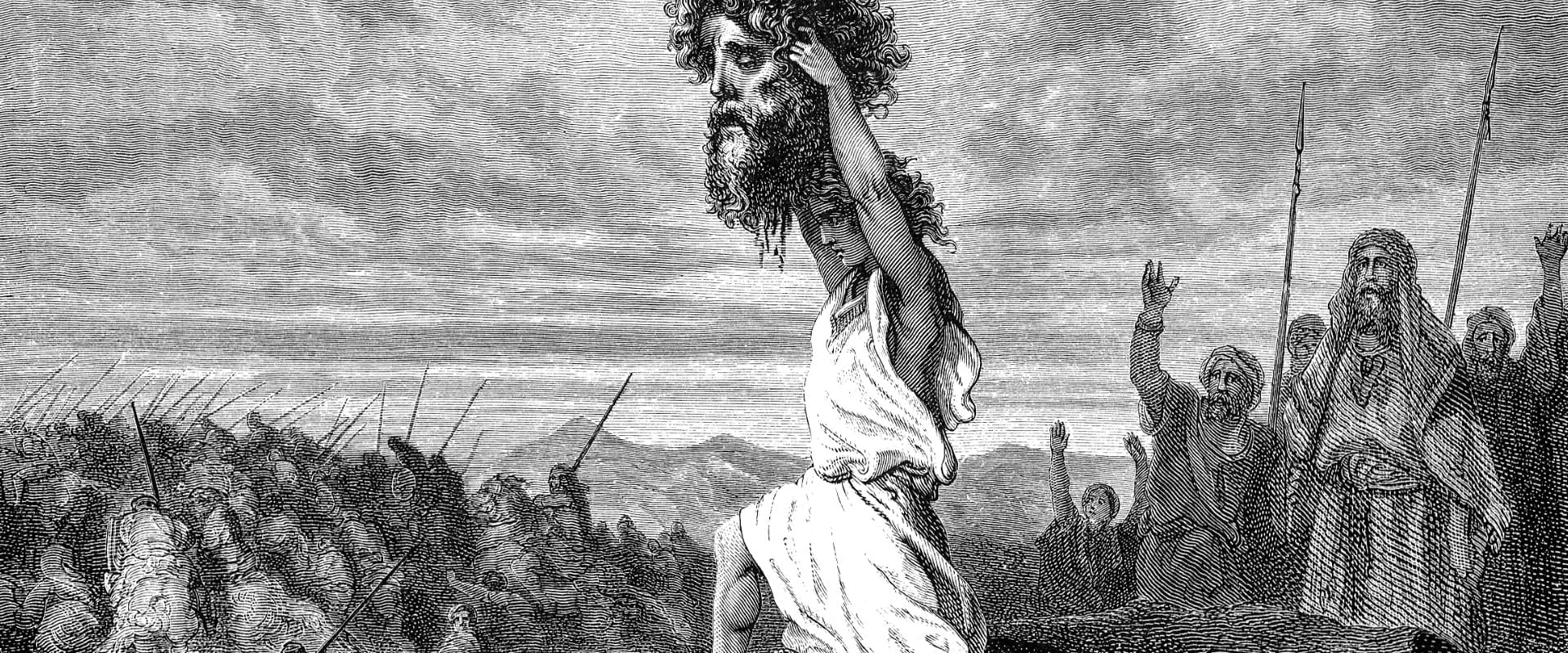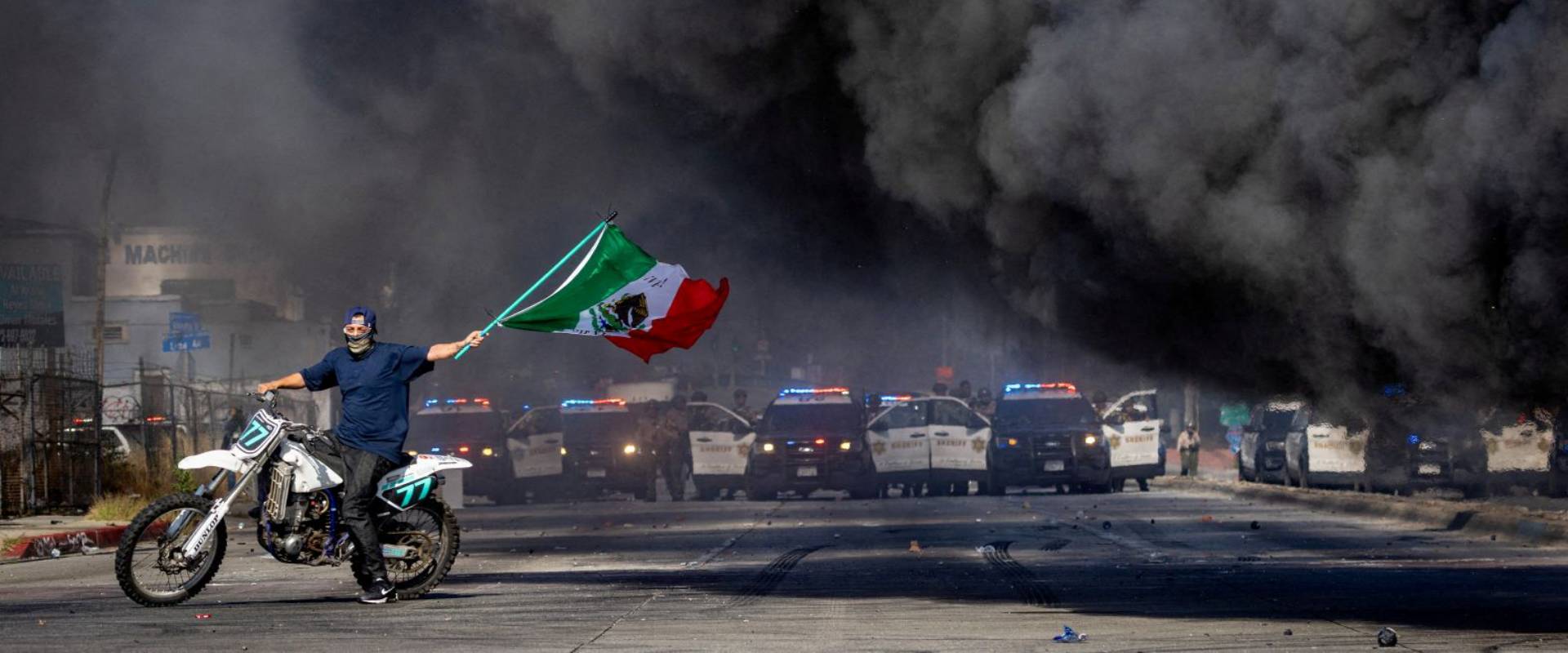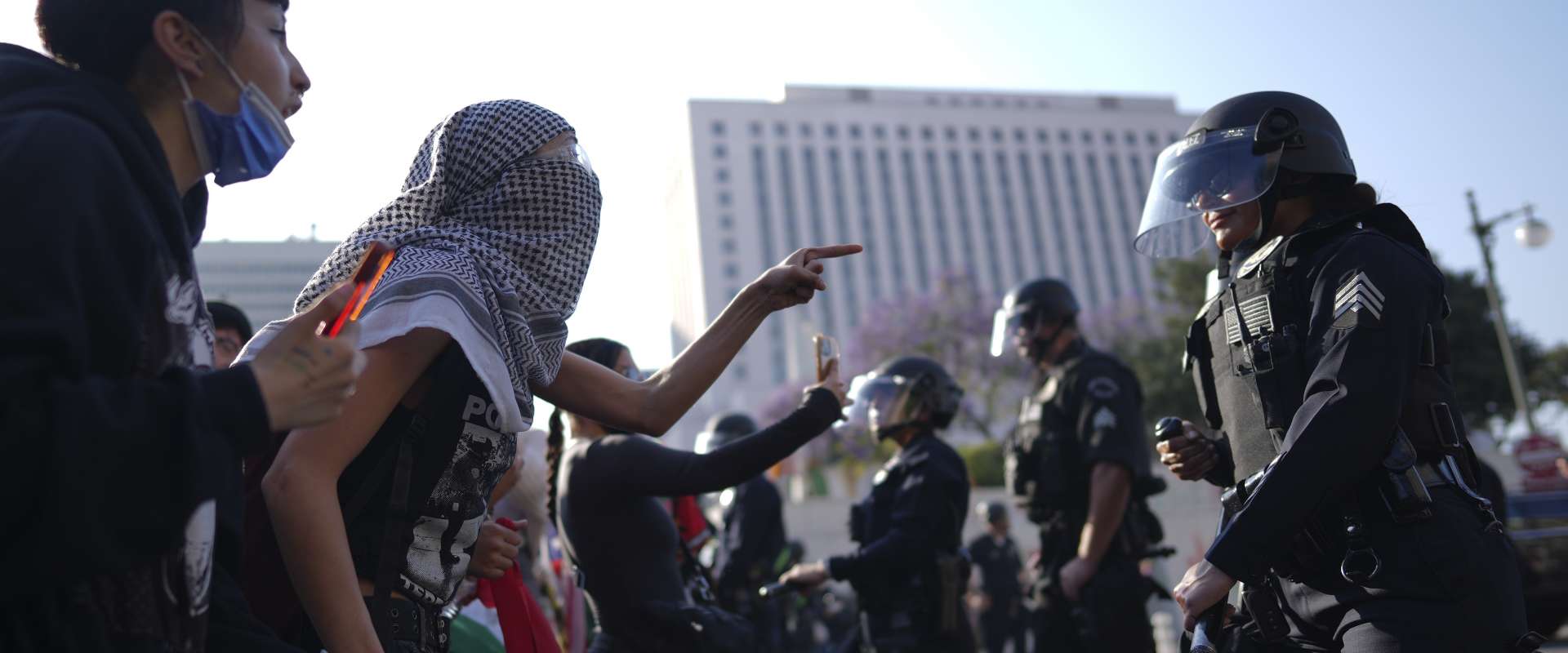The ongoing genocidal annihilation of Gaza and the racist pogroms in the West Bank, both conducted by the Israeli apartheid state with the full support of its imperial sponsor, the United States, have rightfully provoked the rage of tens of millions across the world. In response to these events, Verso Books is offering for free a superb Palestine solidarity reading list (Haymarket is doing the same). These efforts are invaluable gifts, essential in arming our movement with the historical analysis and facts necessary to confront the Zionist ideology deployed by the apartheid state to whitewash its crimes.
Verso’s reading list includes Ilan Pappé’s Ten Myths About Israel. First published in 2017, Ten Myths is an engagingly written narrative history of Zionism and Palestine since the late Ottoman Empire period. Pappé is an anti-Zionist Israeli expatriate and historian based in the United Kingdom. He is one of the pioneers of the New Historians, a school of Israeli scholars who have used archival research and meticulous attention to detail to dismantle the myths of Zionism. Anti-Zionist political scientist Norman Finkelstein has referred to this method as “forensic history.”
Pappé’s most famous book is The Ethnic Cleansing of Palestine, a detailed analysis of the Zionist settler expulsion of Palestinians and the genocidal destruction of Palestinian life in the 1948 Nakba. Ten Myths is more accessible but no less brilliant and incendiary. I cannot recommend it more highly as an inspiration for our work in the international Palestine solidarity movement.
For purposes of this review, I will focus on only a few of the ten myths debunked by Pappé. I do this for two reasons. First, it is easy to get bogged down in details — the microhistories of the dozens of Israeli assassinations, provocations, and air assaults since even 2009 are a morass of actors, imperial manipulations, and territorial jostlings.
Second, issues that have the most direct relation to our current moment — including terms like the Oslo process, the two-state solution, Areas A, B, and C, and the apartheid wall; and actors such as Hamas, the Palestinian Authority, and Netanyahu — all emerge around or after 1993. Thus, the bulk of this review focuses on this more recent history.
Moreover, the “conflict” between the two sides over at least the past 75 years is in fact quite simple. One side is a white-supremacist, settler-colonial project that wants all the land with as few indigenous people on it as possible, while the other side is an indigenous people resisting this colonial land grab. Pappé does an admirable job keeping this fundamental reality in sharp focus while relating in sufficient detail the shifting historical contexts and personalities that have unfolded throughout the past century.
From the river to the sea: Palestine before the Nakba
Pappé argues that the Zionist colonization of Palestine is a clear example of settler colonialism (it is indeed the only currently existing example of this anachronistic form of imperialism). Settler colonialism deploys two logics, the logic of elimination and the logic of dehumanization. According to Pappé, to see Zionism as an example of national self-determination is, at best, simplistic, and at worst, profoundly mistaken.
Rather, Zionism should be placed in the genealogy of European racism and settler colonialism. Thus, “from a settler colonial perspective,” he writes,
events such as the occupation of the West Bank and the Gaza Strip, the Oslo process, and the disengagement from Gaza in 2005 are all part of the same Israeli strategy of taking as much of Palestine as possible with as few Palestinians in it as possible. The means of achieving this goal have changed over time, and it remains uncompleted. However, it is the main fuel that feeds the fire of the conflict.
Zionists have always denied the existence of the Palestinian people and nationhood, referring to them as either “infiltrators,” “terrorists,” or “Arabs.” In fact, Palestinians already understood themselves as a distinct people, with their own cultural specificity, before Zionist colonization. Even during the late Ottoman period, Palestine had rich interactions with the other Arab-majority cultures in the Levant and wider Middle East. At this time, it was a Levantine society like all the other societies around it and “did not differ from the Eastern Mediterranean countries as a whole.”
There have always been Jewish communities in Palestine, long before the arrival of the first Zionists in the late nineteenth century. The indigenous Jewish community did not generally share the Zionist interpretation of Jewish history, nor did they sympathize with the Zionist claim to Jewish ethno-national supremacy over the land.
The fate of Gaza under Zionist occupation is a case in point. Even before October 7 Gaza was, according to the United Nations, “unlivable,” a victim of decades of Zionist colonial “de-development.” Gaza’s marginalization, underdevelopment, and impoverishment were a direct consequence of the Nakba, during which the Zionists carved it off from the rest of Palestine and used it to incarcerate expellees from the surrounding area. Before the Nakba, however, Gaza was a thriving cultural crossroads with a prosperous agricultural hinterland. Gaza was not exceptional in precolonial Palestine.
Even by the early eighteenth century, under capable local rulers such as Daher al-Umar (1690–1775), port towns such as Haifa, Tiberias, and Acre became hubs of trade and cultural connections with the Middle East and Europe, and developed rich connections with the agricultural interior. “The very opposite of a desert, Palestine was a flourishing part of Bilad al-Sham (the land of the north), or the Levant,” as Pappé writes of this time.
By the 1880s, Palestinians from all classes were actively engaged in developing a nationalist feeling and movement. As Pappé explains,
despite there not being a Palestinian state, the cultural location of Palestine was very clear. There was a unifying sense of belonging. At the very beginning of the twentieth century, the newspaper Filastin reflected the way the people named their country. Palestinians spoke their own dialect, had their own customs and rituals, and appeared on the maps of the world as living in a country called Palestine.
In the book’s conclusion, he reiterates that “Palestine was always the land between the river and the sea. It still is […] Peace is not a matter of demographic change, nor a redrawing of maps: it is the elimination of [Zionist racist ideologies and apartheid] policies.”
Palestinian nationalism versus Zionism
This is in no way to deny Jewish claims to Palestine. Indeed, there have always been Jewish communities there, long before the arrival of the first Zionists in the late nineteenth century. The indigenous Jewish community did not generally share the Zionist interpretation of Jewish history, nor did they sympathize with the Zionist claim to Jewish ethno-national supremacy over the land. For their part, the Palestinians tended to welcome the early Zionist settlers and attempted to incorporate them into a multi-ethnic, multi-religious Palestine, but turned to active resistance by the 1930s when the Zionist colonial motivations became more obvious.
What becomes outstandingly clear from Pappé’s contrast between Palestinian nationalism and Zionist nationalism is the qualitative difference between the two projects. While the former became the ethos and political creed of an indigenous people resisting colonialism, the latter cannot be separated from its European settler-colonial character. This is perhaps clearest in the alliances that the two national movements developed during the past 125 years. While the Palestinians were consistently on the side of, and were supported by, progressive and anti-colonial movements of the oppressed throughout the existence of their liberation struggle, Zionism and Israel have almost always sided with reactionary and imperialist forces.
While the Palestinians envisioned a secular, multinational, democratic state with equal rights for Muslims, Christians, and Jews, Israelis favored one state from which Palestinians were expelled and which represented only the Jewish ethnic group. Israel is, and always has been, a bulwark of imperialism and racism, an utterly reactionary force in the Middle East and the wider world.
South Africa during apartheid is a case in point. While the Palestine liberation movement and the South African anti-apartheid movement were solidarizing with each other, Israel was a stalwart ally of South Africa’s dominant white-supremacist minority regime, even attempting to sell it nuclear weapons at one time.
Pappé also reminds us that it was Christian Zionists in Britain, and to a lesser extent in Germany, who were among Zionism’s staunchest supporters between the late nineteenth century and the last days of the British mandate in 1947. These Christian Zionists, such as Shaftesbury, Palmerston, Churchill, and Lloyd George were (it need not be mentioned) fervent British imperialists who saw the creation of Israel as a beachhead of Britannia’s rule. This echoes the view taken by the US ruling class by the early 1970s — Israel as “the largest American aircraft carrier in the world that cannot be sunk,” in the words of Reagan’s secretary of state Alexander Haig.
What must also be noted is the antisemitism of many of these figures. Both Balfour and Churchill, for example, shared the views of the “rabidly antisemitic British ruling class” of their day. For them, Zionism was not a contradiction of antisemitism but a means to realize its objective: facilitating the removal of Jews from Britain.
It’s also worth remembering that in the US today, the largest group that supports Zionism are evangelical Christian Zionists, a group unparallelled in the lunacy of its passion both for Israeli settler colonialism and for US white-supremacist world dominance (and often antisemitic themselves).
Tellingly, in a 2016 poll, pluralities of both Palestinians and Israelis said they favored one state between the Mediterranean and the River Jordan. However, “one state” meant different things to the respective national groups. While the Palestinians envisioned a secular, multinational, democratic state with equal rights for Muslims, Christians, and Jews, Israelis favored one state from which Palestinians were expelled and which represented only the Jewish ethnic group. As the Marxist scholar Max Ajl recently put it, Israel is a “thoroughly bourgeois society.” It is, and always has been, a bulwark of imperialism and racism, an utterly reactionary force in the Middle East and the wider world.
The “peace process”: A geography of disaster
There is a near-consensus in the West that “there is no Palestinian partner for peace.” As Pappé explains, this is nonsense, a falsehood based on Orientalist and racist stereotypes about ingrained Arab irrationality and violence. Indeed, during the Nakba and well into the 1980s, Zionists assimilated the Palestinians into the narrative of the Holocaust, asserting that the latter were motivated, like the Nazis, by antisemitism and the desire to murder Jews. We see this “Nazifying” discourse re-emerge in recent weeks, with Zionists all over social media equating October 7 to the Holocaust and Hamas to the Nazis.
While it is not accurate to say that there is no Palestinian partner for peace — even the much-demonized Hamas charter says that the group is opposed to Zionism, not Judaism, and that it seeks Palestinian sovereignty within the framework of the 1967 borders — it is accurate to say this about the Israeli state. As Pappé shows, far from initiating a “peace process,” the 1993 Oslo Accords under the aegis of US president Bill Clinton were a new phase of the Nakba. As Edward Said wrote shortly after the 1993 handshake between Arafat and Rabin on the White House lawn: “Let us call the agreement by its real name: an instrument of Palestinian surrender, a Palestinian Versailles.”
As Pappé shows, far from initiating a “peace process,” the 1993 Oslo Accords under the aegis of US president Bill Clinton were a new phase of the Nakba.
What Arafat agreed to was the following: in exchange for a semblance of self-government, he accepted the partition of the Palestinians of the West Bank, Gaza, and “Israel proper” along with the exclusion of the refugee issue (the right of return) from the agenda. As Pappé explains, this “rendered the Oslo process at best a military redeployment and a rearrangement of Israeli control in the West Bank and the Gaza Strip. At worst, it inaugurated a new system of control that made life for the Palestinians in the occupied territories far worse than it was before.”
Oslo turned Palestinian territory “into a geography of disaster, which meant that the Palestinians’ quality of life was far worse after the Accord [sic] than it was before.” The occupation forces divided the West Bank into the “infamous” areas A, B, and C, with Area C, over half the territory of the West Bank, under direct Israeli military control. Put another way, the Palestinian Authority has sovereignty over only 18 percent of the area of the West Bank. “Movement between, and inside, these areas became nearly impossible, and the West Bank was cut off from the Gaza Strip.”
From the Zionist perspective, Oslo was a great success. From the Palestinian perspective, it was a disaster. It further entrenched the occupation, undermined living conditions, and positioned any resistance as irrational. By 2000, fed up with this situation, Palestinians rose up in the Second Intifada. Like the First Intifada (1987–1991), it began as a series of nonviolent mass protests. These were, predictably, violently crushed by the Israeli military, a “callous repression (which in turn) led to a more desperate response — the suicide bombers who appeared as the last resort in the face of the strongest military power in the region.”
Israeli violence only escalated at this point. The apartheid state implemented the policy of “targeted assassinations” of Palestinian leaders, which is the real and grim reason why there were soon literally “no Palestinians with whom to negotiate.” Meanwhile, the much-hyped Israeli Offense Forces showed themselves to be a paper tiger, succumbing to a humiliating defeat to Hezbollah, which expelled the IOF from southern Lebanon in 2000. The IOF now felt it needed to “show its strength.” Enter the 2002 “Operation Defensive Shield,” the largest assault on Palestinians since the 1967 war, along with the nefarious apartheid wall that sliced into the already dismembered West Bank.
Branding resistance as “terrorism”
Created with the blessing of the Israeli state as an offshoot of the Muslim Brotherhood in the late 1980s, Hamas distinguished itself as a political organization from Arafat’s more secular Fatah party in two ways: it rejected Oslo as a figleaf for the occupation and it refused to renounce armed resistance. Although Hamas lost some popularity in the early days of Oslo, by the early 2000s, as the farce of the “peace process” became evident, the Islamist group saw its political hopes revive.
After Arafat died in 2004, with Fatah deeply discredited because of its collaboration in the occupation, Hamas saw two electoral successes. In the 2005 municipal elections, it took control of over one-third of the municipalities in the occupied territories. But its major breakthrough was in the 2006 election for the national legislative assembly, where it won a majority and therefore the right to form a government. For the Americans and the Israelis this was too much. They had been excoriating the Palestinians for being undemocratic and unreasonable — “no partner for peace” — and it was the US which had been exerting pressure for elections in the first place. In their racist (il)logic, the free, fair, professionally conducted election, in the assessment of both the Carter Center and the European Union, yielded the wrong result. The victory of Hamas was for them further proof of the “violent intransigence” of the Palestinians, and Fatah, in collaboration with the Israelis and the Americans, ousted them from power in the West Bank.
As Pappé explains, Hamas were simply always going to be politically unpalatable to the Israelis and their American patrons: “Hamas’s unwillingness to accept the Oslo Accord, its refusal to recognize Israel, and its commitment to armed struggle” were why Hamas was “branded as a terrorist organization, both in the media and in legislation.” However, Hamas was by now
deeply embedded in Palestinian society thanks to its genuine attempts to alleviate the suffering of ordinary people by providing schooling, medicine, and welfare. No less important, Hamas’s position on the 1948 refugees’ right of return, unlike the PA’s stance, was clear and unambiguous. Hamas openly endorsed this right, while the PA sent out ambiguous messages, including a speech by Abu Mazen in which he rescinded his own right to return to his hometown of Safad.
In Pappé’s view, this is why Hamas should be seen as “a liberation movement, and a legitimate one at that.”
Gaza: From incremental to outright genocide
Hamas’s sin of fairly contesting elections roughly coincides with Israel’s decision to evacuate settlers from Gaza in the late summer of 2005. This was a move falsely represented in the West as a peaceful gesture and a strategy of self-defense on the part of Israel. As Pappé shows, it was in fact the prelude to a crueler phase of the ongoing Nakba, part of a larger strategy “intended to strengthen Israel’s hold over the West Bank and to turn the Gaza Strip into a mega-prison.” The 2005 removal of Gaza settlers was thus a chapter in an “incremental genocide of the people of Gaza.”
As Pappé explains, Hamas were simply always going to be politically unpalatable to the Israelis and their American patrons: “Hamas’s unwillingness to accept the Oslo Accord, its refusal to recognize Israel, and its commitment to armed struggle” were why Hamas was “branded as a terrorist organization, both in the media and in legislation.”
Since the 2006 election, Israel has instituted one of the cruelest blockades in history. Even before the October 7, 2023 attacks, it was deliberate Israeli policy to keep the population of the Gaza Strip, over 2.4 million people, with a population density greater than that of Tokyo, barely above the level of starvation. Even before October 7, the blockade had wrecked Gaza’s economy, with overall unemployment higher than 45 percent and the poverty rate well above 50 percent. Severe limits on fuel meant that water treatment was profoundly compromised, causing salinity and nitrate levels to skyrocket “well above” guidelines for safe drinking water (according to a 2021 WHO report). Over half of the Strip’s population is under the age of eighteen, and half of those kids suffer water-borne infections. By 2016, as Finkelstein points out, the Gaza Strip was “dependent for about 90 percent of its GDP on expenditures by the Palestinian Government, the United Nations and other external remittances and donor projects.” In 2012, the United Nations stated that the Gaza Strip was a victim of “de-development” — colonialism, if one likes — and would become “unlivable” by 2020.
In one of the more arresting passages in a book full of them, Pappé discusses how the genocidal logic on full display in Gaza today had already become mainstream two decades ago. By 2004, he writes
Opinions that used to be considered at best marginal, at worst lunatic, were now at the heart of the Israeli Jewish consensus, disseminated by establishment academics on prime-time television as the one and only truth. Israel in 2004 was a paranoid society, determined to bring the conflict to an end by force and destruction, whatever the cost to its society or its potential victims. Often this elite was supported only by the US administration and the Western political elites, while the rest of the world’s more conscientious observers watched helpless and bewildered. Israel was like a plane flying on autopilot; the course was preplanned, the speed predetermined. The destination was the creation of a Greater Israel, which would include half the West Bank and a small part of the Gaza Strip (thus amounting to almost 90 percent of historical Palestine). A Greater Israel without a Palestinian presence, with high walls separating it from the indigenous population, who were to be crammed into two huge prison camps in Gaza and what was left of the West Bank. In this vision, the Palestinians in Israel could either join the millions of refugees languishing in the camps, or submit to an apartheid system of discrimination and abuse.
The future: Cracks in the edifice
Ten Myths About Israel is a remarkably prescient analysis of Zionism’s current trajectory. “The charade” (the two-state solution), Pappé writes in the conclusion, “will end soon, peacefully or violently, but either way painfully. It seems that nothing is going to stop Israel now from completing its colonization of the West Bank and continuing its siege on Gaza.”
Along with running roughshod over the rights of the Palestinian people and forfeiting its right to be considered an acceptable political ethos within any moral understanding of humanity, Zionism has done profound violence to our language and our imagination.
In ancient times, the dead were buried with their beloved artifacts and belongings. This coming funeral will probably follow a similar ritual. The most important item to go six feet under is the dictionary of illusion and deception with its famous entries such as “the peace process,” “the only democracy in the Middle East,” “a peace-loving nation,” “parity and reciprocity,” and “a humane solution to the refugee problem.” A replacement dictionary has been in the making for many years, redefining Zionism as colonialism, Israel as an apartheid state, and the Nakbah as ethnic cleansing. It will be much easier to put it into common use once the two-states solution has been pronounced dead.
For Pappé, the Palestinian campaign of boycott, divestment, and sanctions (BDS) against the Israeli state and its capitalist class is essential in the struggle to liberate Palestine. Recruiting progressive Jews to the movement is also an urgent task, one which has received a major boost during the latest bloodbath.
Other than this, Pappé, with his humble historian’s method, is understandably reticent about the future. I would only add that events since October 7 have both been astonishing and, if not predictable, then unsurprising. Astonishing has been how the Palestinian fighters exposed the vulnerabilities of the hyped IOF intelligence and surveillance competence and the faultlines within Israeli society. Unsurprising have been the ferocity of Israel’s response — over 14,000 Palestinians, 5,600 of them children, dead and counting by the time of writing — and the slavish support of both the US and European ruling regimes.
There are, however, glimmers of hope amid the horror: the huge rallies for Palestine across the world, including the largest ones ever in the belly of beast, the US; the global revival of international solidarity; the formation or invigoration of activist networks of Palestine solidarity — including, and particularly frightening to the Zionist project, among younger Jews in the West; and the new passion especially among the youth for real education about Zionism’s settler-colonial nature and its gargantuan crimes.
Quoting the Palestinian-American historian Rashid Khalidi, the author Ta-Nehisi Coates recently argued that “Never has the movement been as powerful as it is right now.” While at the time of the publication of Ten Myths About Israel it may have sounded fanciful to say that our movement has Zionism on its backfoot , this sounds less fanciful today. US imperialism will continue to ferociously defend its “unsinkable aircraft carrier” for the foreseeable future, but it is undeniable that cracks in the edifice are beginning to appear. Ilan Pappé’s book is invaluable in helping us more clearly see through Israel’s myths and therefore, a future in which all peoples between the river and the sea — Muslims, Jews, and Christians — live in freedom, equality, and dignity.
Map courtesy of SoWhAt249 [CC BY-SA 4.0], via Wikimedia Commons



